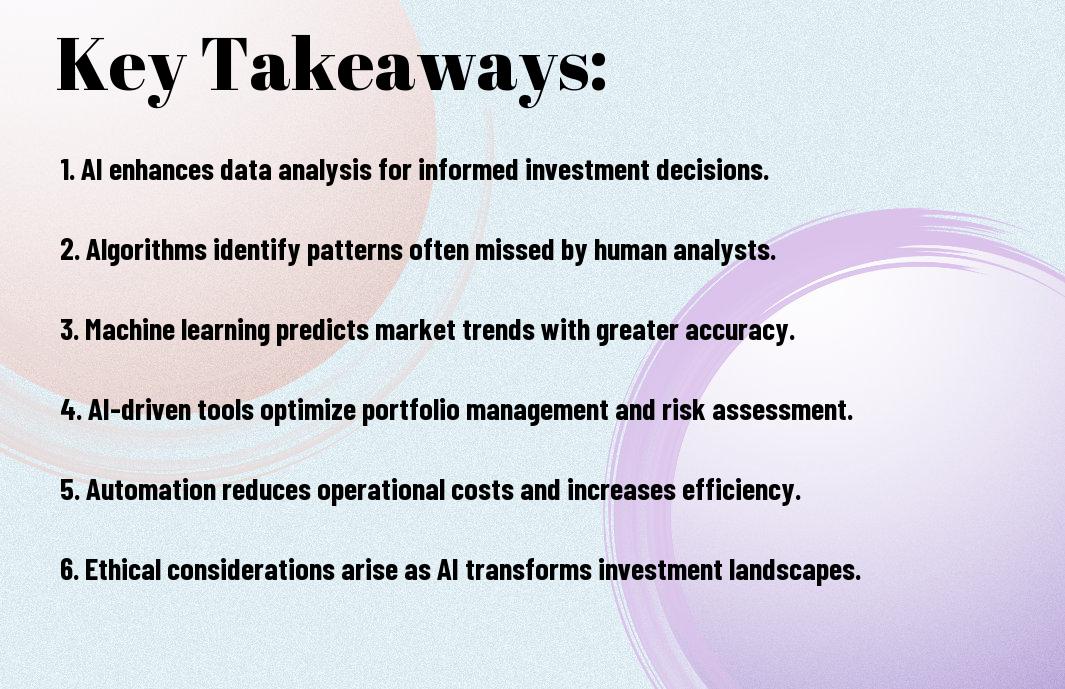Finance is rapidly evolving, and understanding the role of artificial intelligence (AI) in investing can significantly enhance your decision-making process. AI technologies can analyze vast amounts of data, identify trends, and generate insights that were previously difficult to obtain. By incorporating AI into your investment strategy, you can optimize portfolio management, reduce risks, and improve returns. This post will explore how you can leverage these advanced tools to make informed investment choices and stay ahead in a competitive market.
Key Takeaways:
- Data Analysis: AI enhances the ability to process and analyze vast amounts of financial data, identifying patterns and trends that human analysts may overlook.
- Risk Management: AI algorithms can assess risk by evaluating numerous variables in real time, allowing for more informed investment decisions and reducing potential losses.
- Portfolio Optimization: Machine learning models can optimize investment portfolios by continuously adjusting asset allocations based on market changes and predictive analytics.


Understanding Artificial Intelligence
For you to fully grasp the implications of artificial intelligence (AI) in investing, it is necessary to understand its fundamental concepts. AI involves the simulation of human intelligence processes by computer systems, which include learning, reasoning, and self-correction. This understanding illuminates how AI can enhance investment strategies, risk management, and market predictions.
Definition and Types of AI
For a clearer picture of AI, consider the various forms it takes:
- Machine Learning: Systems that learn from data patterns.
- Natural Language Processing: Understanding and generating human language.
- Robotic Process Automation: Automating repetitive tasks.
- Deep Learning: A subset of machine learning involving neural networks.
- Expert Systems: Providing decision-making support based on knowledge databases.
Recognizing these types helps you appreciate how they can be tailored to meet specific investing needs.
| Type of AI | Description |
|---|---|
| Machine Learning | Analyzes data to recognize patterns and improve decisions. |
| Natural Language Processing | Interprets and generates human language, aiding market sentiment analysis. |
| Robotic Process Automation | Streamlines repetitive tasks, enhancing efficiency. |
| Deep Learning | Utilizes layered networks to process complex data comprehensively. |
| Expert Systems | Provides complex decision-making based on specific domains of knowledge. |
Historical Context in Finance
For you to appreciate AI’s role in investing, consider its historical development within finance. Over the past decades, the advent of sophisticated algorithms has transformed trading, allowing for faster and more efficient transactions. Early adopters leveraged technology to gain a competitive edge, setting the stage for today’s increasingly automated investment landscape.
Considering the path AI has taken in finance, you can see how its evolution has influenced market dynamics. From basic algorithmic trading in the 1980s to advanced quantitative strategies, technology has reshaped your investing landscape. The integration of AI tools into financial analysis, portfolio management, and trading has become vital for those looking to navigate complex markets effectively, enabling you to make more informed, timely decisions based on intricate data analysis. As your understanding deepens, you can harness these advancements to enhance your investment strategies.
Benefits of AI in Investing
While traditional investing methods can be time-consuming and prone to human error, integrating AI offers numerous advantages. You can streamline your investment strategies, gain insights from vast data sets, and ultimately enhance your portfolio’s performance. AI not only increases efficiency but also empowers you to make more informed investment decisions based on accurate predictions and trends.
Enhanced Data Analysis
An effective investment strategy relies on the ability to analyze vast amounts of data quickly. With AI, you can leverage advanced algorithms to sift through historical data, market trends, and news sentiment, enabling you to identify potential investment opportunities with precision. This enhanced data analysis equips you with the necessary insights to make informed choices tailored to your investment goals.
Improved Decision-Making Processes
Enhanced decision-making processes stem from AI’s ability to process data in real-time, minimizing biases that human investors might have. This ensures that your investment choices are based purely on data and predictive analytics, allowing for more optimal outcomes. With improved decision-making, you are better prepared to navigate market fluctuations and capitalize on emerging opportunities.
Even as market conditions change, AI can adapt its algorithms to provide continuous improvements in your decision-making processes. By assessing risk factors, predicting market movements, and generating actionable insights, AI enables you to respond swiftly to emerging trends. It serves as a valuable tool in your investment arsenal, increasing your confidence in making timely and educated decisions that align with your financial objectives.
AI Algorithms and Strategies
All modern investing strategies leverage AI algorithms to analyze vast amounts of data, enhance decision-making processes, and identify potential investment opportunities. These algorithms are designed to detect patterns and trends that may evade traditional analytical methods, allowing you to optimize your portfolio and reduce risk. By integrating AI into your investing approach, you benefit from a more informed perspective, enabling you to navigate complex financial markets with greater confidence.
Machine Learning Techniques
On a fundamental level, machine learning techniques empower you to build predictive models that adapt to new data over time. These techniques utilize frameworks like supervised and unsupervised learning, helping you forecast stock prices, assess company performance, and uncover hidden investment opportunities. By relying on machine learning, you can harness historical data to better understand market dynamics and make more informed decisions in your investment journey.
Quantitative Trading Models
With quantitative trading models, you can apply statistical methods to trading strategies, maximizing returns through data-driven insights. These models analyze historical market data to identify trends, correlations, and anomalies that inform your trading decisions. By using rigorous mathematical techniques, you can backtest your strategies against historical performance, helping you adapt your approach based on empirical evidence rather than emotions.
Further exploring quantitative trading models, you’ll find them to be particularly effective in executing high-frequency trading strategies, where speed and efficiency are vital. By applying algorithms that process real-time data, you can capitalize on minute pricing discrepancies in the market. These models often deploy sophisticated risk management techniques to protect your investments while allowing for rapid entry and exit points. Overall, quantitative trading enhances your ability to navigate the intricacies of financial markets with precision.
Risks and Challenges of AI in Investing
Once again, while artificial intelligence can enhance investing strategies, it is important to acknowledge the inherent risks and challenges involved. You may face issues such as algorithmic bias, data quality concerns, and market unpredictability, which could hinder your investment decisions. Thoroughly understanding these risks will enable you to navigate the complexities of AI in investing more effectively.
Data Privacy and Security Concerns
For many investors, the rising integration of AI raises significant data privacy and security concerns. You need to be aware that the collection and analysis of vast amounts of personal and financial data can expose you to potential breaches and misuse. Safeguarding your information must be a priority in an increasingly digital investing landscape.
Over-Reliance on Technology
Across the investment world, there’s a growing tendency to overly rely on technology and AI systems for decision-making. You might find that while these tools can provide valuable insights, putting too much faith in them can lead to a disconnect from fundamental analysis and market intuition.
Concerns regarding over-reliance on technology in investing highlight the need for a balanced approach. While AI can process vast datasets at incredible speeds, it’s important that you maintain a degree of skepticism and critical analysis in your investment strategies. Relying exclusively on machine-generated insights can lead to poor decision-making, particularly in volatile markets where human intuition can provide context that algorithms might miss. By blending technology with your judgment, you can enhance your decision-making without losing sight of important market dynamics.
Case Studies of AI in Investment Firms
To illustrate the effectiveness of Artificial Intelligence in investment management, various firms have adopted AI-driven strategies with remarkable outcomes:
- BlackRock utilized AI tools to analyze 200 million data points, enhancing their portfolio optimization processes.
- Goldman Sachs leveraged AI algorithms to execute trades, achieving a 20% improvement in trade efficiency.
- Bridgewater Associates incorporated machine learning models to predict economic trends, reportedly increasing returns by 10%.
- JP Morgan’s AI systems, described in detail in Can investment management harness the power of AI?, help assess thousands of companies in seconds, leading to faster decision-making.
Success Stories
Before delving into the capabilities of AI in investment, it’s necessary to highlight some notable success stories where firms have transformed their approaches. For instance, Wealthfront used AI to create personalized financial plans, significantly improving client engagement and satisfaction.
Lessons Learned
Behind the transformations, several important lessons have emerged regarding the integration of AI in investment processes. Understanding data quality and infrastructure is critical, as poor data can lead to flawed models and misguided strategies. Analytics alone do not guarantee success; the human element remains vital in interpreting AI insights.
For instance, firms that rushed the implementation of AI without proper training and adaptation faced hurdles like resistance from traditional analysts. They learned that fostering a culture of collaboration between data scientists and finance experts can enhance the effectiveness of AI-driven initiatives, ensuring that technology serves to augment, rather than replace, human decision-making.
Future Trends in AI-Driven Investing
Many investors are beginning to recognize the transformative potential of AI-driven investing. As automated systems become increasingly sophisticated, you can expect enhanced decision-making, improved risk management, and personalized investment strategies tailored to your unique financial goals. The future of investing is poised to leverage AI technologies for deeper insights and more efficient portfolio management.
Emerging Technologies
For investors today, staying ahead of emerging technologies is vital for capitalizing on new opportunities. Tools such as machine learning and natural language processing are enabling you to analyze massive datasets in real time, leading to insights previously unattainable. As these technologies evolve, your investment strategies will become more dynamic, allowing for quicker, more informed decisions.
Evolving Investor Relationships
To benefit from AI in investing, you must understand how these changes will redefine your relationship with financial professionals and platforms. The integration of AI will not only enhance your user experience but also provide more transparent and tailored investment options suited to your preferences.
Due to AI’s ability to process vast amounts of data and uncover trends, you will find that your relationship with investment advisors evolves to focus more on strategy rather than data crunching. This shift will foster collaborative partnerships, where human intuition complements AI analytics, leading to more informed, personalized investment decisions. You may increasingly rely on your advisors for navigating complex financial landscapes while benefiting from AI-backed insights that drive successful outcomes.
Conclusion
Taking this into account, the role of artificial intelligence in investing offers you unparalleled insights and efficiency. By leveraging AI tools and algorithms, you can analyze vast amounts of data, identify trends, and make informed decisions in real-time. This technology not only enhances your investment strategies but also helps mitigate risks, ultimately empowering you to navigate the complex market landscape with greater confidence and precision. Embracing AI in your investment approach can lead to more strategic outcomes and improved financial performance.
Q: How does artificial intelligence enhance the investment decision-making process?
A: Artificial intelligence enhances the investment decision-making process by analyzing vast amounts of data at speeds and accuracies beyond human capabilities. It utilizes algorithms and machine learning to identify patterns, trends, and anomalies in market data, allowing investors to make more informed decisions. Additionally, AI can help in predictive modeling, enabling investors to forecast potential market movements based on historical data. This results in more strategic and evidence-based investment choices.
Q: What are some AI tools and technologies commonly used in investing?
A: There are several AI tools and technologies that are widely utilized in investing. Natural language processing (NLP) is employed to analyze news articles, earnings reports, and social media sentiment, providing insights into market reactions and investor sentiment. Robo-advisors use algorithms to create and manage investment portfolios based on individual risk profiles. Additionally, machine learning platforms can create predictive models that help in stock price forecasting and risk assessment.
Q: What are the potential risks associated with AI in investing?
A: While AI presents significant opportunities in investing, it also comes with risks. One potential risk is the reliance on algorithms that may inadvertently propagate biases present in training data, leading to skewed investment decisions. Additionally, AI systems can be vulnerable to cyber threats, which could compromise sensitive financial data. Furthermore, market dynamics can change rapidly, and AI models that rely on historical data may not always adapt well to unforeseen circumstances, leading to poor investment outcomes.
